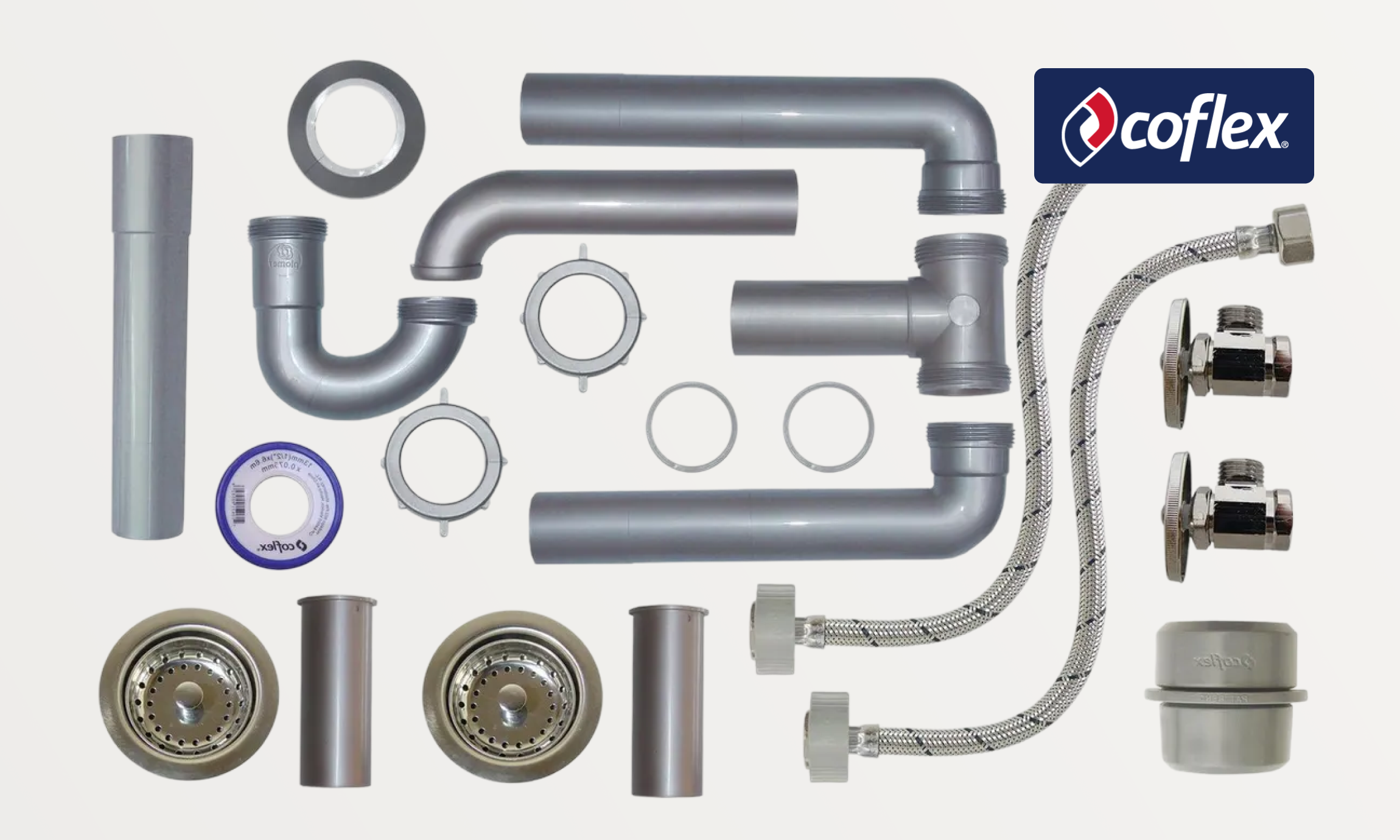
Mexico’s leading manufacturer of flexible connectors for the plumbing and construction industries, Coflex, isn’t only raising the bar for innovative products — it’s also committed to setting the standard in B2B eCommerce. The secret weapon? Strong collaboration between commercial and IT teams for world-class digital transformation.

Since its founding in 1989, Coflex has been a pioneer in innovation within the plumbing and water systems sector in its home turf in Mexico, as well as over 20 countries in Latin America. Recognizing the importance of providing digital experiences aligned with today’s buyer expectations, the company established a digital transformation project to modernize its eCommerce offering — Coflex Online — to provide a more intuitive customer experience and modernize the relationship with distributor customers.
Coflex already provided an eCommerce portal built on Magento (now known as Adobe Commerce), but functionality was limited. The platform’s B2C focus required extensive modifications to accommodate B2B functionality, and it wasn't delivering the features they needed for their business requirements. As a result, the customer adoption rate was low, preventing Coflex from leveraging digital-based sales to grow revenue. To retain its leadership position in the market — not only as a product category leader but also as a leader in digital experience — the company needed a more flexible infrastructure behind Coflex Online.
Selecting commercetools B2B Commerce as the technology layer was a critical step, providing the flexibility needed to gather valuable data on how to improve the platform and adapt to customer needs on the fly. This approach has allowed distributors and SMB businesses to make purchases through a seamless checkout experience, check their account statements, make payments and manage credit notes, all from a single place. The result was a marked increase in customer engagement and operational efficiency.
Customer adoption soared: Just six months after launch, 80% of customers and 89% of the sales force had adopted the new portal. The shift to a composable, B2B-optimized platform contributed to significant revenue growth through increased digital transactions, improved customer engagement and a successful hybrid sales model that blends self-service and assisted sales seamlessly.
While selecting the right technology was crucial for Coflex’s digital success, it wasn’t the only driving factor. In fact, as the company had to modernize in only 90 days, the team wanted to showcase the new eCommerce portal at an annual event only three months away — what stood out as a success driver was the strong collaboration between commercial and technology teams.
Driving digital transformation through cross-team collaboration
Developing the best industry portal was a top-priority initiative backed by the C-level and officially designated a “Blue Project,” a status reserved only for Coflex’s most critical undertakings. With this designation came the need for tight alignment and seamless collaboration between commercial and IT teams.
The leaders responsible for this feat, Omar Martinez, Commercial Director, and Javier Huesca, Development Director, highlighted how important it was to see each department as a strategic ally to drive a project of such complexity.
Coflex’s collaborative approach to digital transformation is a showcase of success. While many organizations struggle to align even basic requirements across teams or fight over project ownership, deadlines and deliverables, the partnership here was a no-brainer. As Javier said, “The key to our success was that leadership came from the commercial side. Omar’s leadership from the beginning was instrumental. He set the pace and direction for the entire implementation process, which made all the difference.”
From the commercial perspective, Omar highlighted how essential IT had become in today’s sales environment: “In the past, people used to think of IT as just fixing internet or computer issues. But today, it’s a strategic partner. IT brings in global processes, cutting-edge technologies and deep knowledge of industry trends. They help us optimize costs, improve connectivity and create stronger engagement with customers.”
Both leaders agreed that cross-functional collaboration was what made the difference. Communication flowed constantly between their teams, ensuring everyone was aligned with the project goals and timeline.
“It was a big challenge,” Javier noted. “But thanks to shared leadership and open communication, we delivered on time.”
How Coflex drove a frictionless digital transformation process
When it came to shaping the direction of the new B2B eCommerce platform, the team took a structured and agile approach to decision-making. Javier explained that, in collaboration with their implementation partner, Keyrus, they defined a series of development sprints — ten in total, each with its own testing/QA (quality assurance) within the sprint period — leading up to the platform's launch at the leading industry event, Expo Nacional Ferretera (National Hardware Show) in September 2024.
To ensure the project remained on track, the team implemented a multi-tier meeting structure. This included weekly operational meetings to monitor progress closely, as well as monthly executive updates to keep the company’s leadership fully informed. This rigorous cadence of communication played a key role in maintaining focus and momentum throughout the development cycle.
Javier also shared insights into the platform migration strategy. Initially, the team planned to sunset the original Coflex 1.0 platform, built on Magento, and its supporting internal sales tool, Coflex Mobile, about a year after the new Coflex Online (built on commercetools) went live.
Ultimately, prioritization for the MVP in the first 90 days focused on functionality that delivered the highest immediate value to both external and internal stakeholders. Trade-offs were strategically made, with close collaboration between business and technical teams to ensure alignment on goals and deliverables at every stage. The full migration was completed in six months.
Early feedback and adoption drove this accelerated timeline. Distributors quickly recognized the advantages of the new platform, including improved functionality and user experience. Internally, operational and sales teams appreciated how much easier the system was to use. These positive responses validated the decision to bring forward the migration and reinforced the platform’s value across the ecosystem.
Making change management a key factor to digital success
One of the most critical success factors in the digital transformation journey was a well-executed change management strategy, particularly within the sales organization. Javier emphasized that without strong change management, the platform could have been a “nice-to-have” tool. Instead, the strategy made the vision a reality.
From the beginning, Omar and the team prioritized a customer-centric approach, mapping out the customer journey holistically and identifying the key processes that needed digital support. One of the first priorities was optimizing the order-to-cash (OTC) process, a core workflow that significantly affected sales performance.
Omar explained that this transformation brought major changes to how sales reps operated. “It was a big shift. Sales reps were used to taking orders manually, so they needed to understand and trust a new system, know exactly what to do and evolve into business advisors instead of simply order takers.”
The change management approach proved effective. Once sales reps saw how easy and intuitive it was to use the portal, they embraced the change. Customers responded positively, often commenting on how easy it was to do business with the company. To further encourage adoption, sales reps receive incentives for onboarding customers to the eCommerce portal, earning up to 25% of their commercial development targets through digital engagement.
Lead times have been reduced significantly and sales reps can now hit their targets more efficiently. The system also enables better cross-selling, upselling and even smoother payment processes. Plus, sales reps, once focused on taking orders, are now empowered as trusted advisors, delivering greater value to customers and strategically contributing to business growth.
This success was also rooted in the company’s long-standing culture of innovation. As Omar described, “Doing things differently has always been in our DNA. From our early days developing patented plumbing products, we’ve never followed the standard path.”
Continuing the digital journey
To Omar, “This is just the beginning. Digital transformation is an ongoing journey. As a leader in our industry, we have the responsibility to set the standard and be the reference point in how business is done digitally. That means staying ahead of trends, understanding new processes and maintaining continuous communication across all areas of the organization.”
Coflex’s commitment is to make it even easier to become more business-friendly for all customer stakeholders within B2B organizations, such as:
Accounts payable should find it easy to manage payments.
Logistics should have real-time visibility into volumes and shipments.
Accounts receivable should be able to validate credit notes efficiently.
Inventory and operations must rely on accurate, real-time data to ensure continuity.
“Meeting these expectations is the challenge, and we can only achieve it by business and technology teams working together. Without alignment, we won’t reach our goals. But with the right focus and collaboration, we’ll continue to lead the market,” concluded Omar.
From a technical standpoint, one of Coflex’s upcoming challenges is the transition to a new ERP system. This requires integrating Coflex Online with commercetools and the new ERP through APIs and web services, enabling more seamless experiences.
Moreover, the company is focused on continuing to enhance functionality, from optimizing its search engine and improving data-centricity.
“We’re not standing still,” said Javier. “This project laid the foundation and the next phase is about scaling, optimizing and continuing to lead the industry through innovation.”
Explore how composable commerce can unlock your B2B digital transformation.
